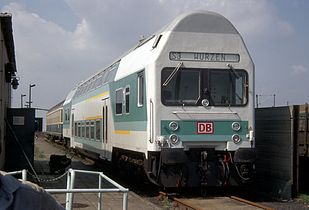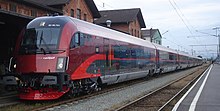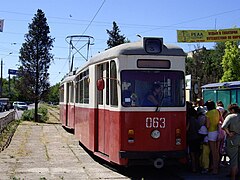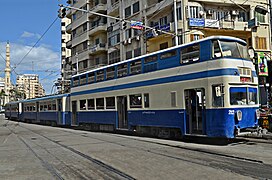Control car
A control car is a non-powered train or tram car with a driver's cab from which a motor vehicle that is not running on the Zugspitze can be controlled. Control cars have all the necessary vehicle equipment for train control . Control cars are used in push-pull trains so that the locomotive no longer has to be moved at terminal stations (from one end of the train to the other). The use of control cars streamlines railway operations, as no infrastructure is used for the relocation and additional staff in the form of a shunter is saved: the locomotive driver simply changes the driver's cab. If the controlling car is itself a traction vehicle, one speaks of a multiple traction .
Control cars are designated with the generic letter "f" (driver's cab) according to the type designation system for passenger coaches in Germany and Austria . In Switzerland the letter "t" is used as a label, in Italy "p" (pilota). In some countries there is no specific marking for driving cars, the "x" found on French driving cars can also stand for other "special equipment".
development
In addition to the classic passenger trains, where locomotives had to be changed to change direction, there were already passenger trains without locomotives, the multiple units. The drive and the driver's cabs could be relocated to the cars, which reduced space requirements and weight. In some cases, push-pull trains were already being formed in that railcars, control cars and passenger cars from the normal fleet, which were equipped with control cables, could be combined into compositions of variable lengths.
The pioneer of push-pull train transport with locomotive-hauled trains was the French company Chemins de fer de l'État in 1933 with their double-decker suburban trains . In 1936 the double-decker streamlined push-pull train of the Lübeck-Büchener Railway followed , with the last double-decker car being equipped with a driver's cab at the end of the train. The two-part double-decker trains were equipped with a direct push-pull train control, the steam regulator of the locomotive was moved by an electric motor. Experiments with control cars and steam locomotives converted for push-pull operation were also carried out by the then Deutsche Reichsbahn (DR) after it had also been proven in 1936 that the driving behavior of a pushed train practically does not differ from that of a pulled train. In 1948, the SBB first used a control car with a Re 4/4 locomotive in express trains from Zurich to Lucerne. With the change from steam traction to electric traction and also diesel traction , the general spread of control cars began, as the remote control of electric locomotives and diesel locomotives could be more practical and uncomplicated than steam locomotives. Initially only used in local traffic, modern control systems and improvements in running properties made it possible to also use it in long-distance traffic from the 1980s.
commitment
Germany (after 1950)
Local transport
At the Deutsche Bundesbahn , control cars were initially only used in multiple units, these were similar in appearance to the corresponding multiple units, had a driver's cab on one side, but no drive. This was the case with the pre-war developments as well as with the multiple units developed in-house such as the VT 08 , VT 12 , VT 98 and ETA 150 . The railcar control cars had their own series designations: VS 08, VS 12, VS 98 and ESA 150. These control cars could only be used with the corresponding railcars and, with the exception of the VS 98 and ESA 150, were permanently coupled to the multiple units. The two-part diesel multiple units of the 628 series also only have one powered bogie; one half of the multiple unit is designed as a control car and is denoted by 928 in a different way .
The German Federal Railways purchased in 1951 at the Eilzugwagen and cars with control compartment and Wendezugeinrichtung. When ordering the n-wagons, DB also ordered larger-scale control cars from various manufacturers. These first control cars of the type BDnf 738 differed from the cars without a control compartment only in the installation of two windows, a luggage compartment and an auxiliary driver's cab on one end of the car. As usual, these cars could also be lined up between two other passenger cars and had gangways for passengers. In 1966, 350 cars of this type were in use. Since the driver's cab offered little space and comfort, these control cars were only partially suitable for consistent use in front of push-pull trains ; they were nicknamed Hasenkasten by the locomotive crew . For new acquisitions, from 1971 onwards, pure control cars without transition options, which were equipped with a regular driver's cab, were chosen; the old control cars were either converted or taken out of service. After the prototype manufactured in the AW Karlsruhe, they were called the Karlsruher Kopf . A total of 309 cars had been produced by 1977. Some of the older control cars also received the new control compartment. These control cars could only be used for diesel or electric traction. They have been modified by different manufacturers, so that there is a multitude of substructures.
The S-Bahn operation introduced by the Federal Railroad in the 1970s opened up new uses for push-pull trains. On the S-Bahn Rhein-Ruhr , railcars of the 420 series were initially used on a test basis . For a series order, however, it was decided to use locomotive-hauled trains, which should run as a fixed unit in push-pull operation in conjunction with control cars. The result was the x-cars , which were initially used in conjunction with class 111 locomotives and , after the fall of the Wall, with class 143 locomotives. The associated control car is called Bxf 796 . The first three prototypes of this control car were completed in 1978 and 1979, followed by 102 control cars for the S-Bahn Rhein-Ruhr and the S-Bahn Nuremberg between 1981 and 1990 . The control car of the x-Wagen was the first type equipped with time-division multiplex push-pull train control. Unlike earlier control cars, the signals for controlling the locomotive are transmitted digitally instead of analog . In addition, the DB standard driver's cab was used for the first time .
The Deutsche Reichsbahn also initially only used control cars for railcar units in regular operations. The first series control car for locomotive hauled trains were, after lengthy trials and operation with individual pieces, the conversions from E5 central entry control cars for the Leipzig S-Bahn. This is followed by the five-part double-decker articulated trains DGBgqe of type 1970, the four-part double-decker units DBvqe of type 1971 and finally, from 1974, the double-decker single wagons DBmqe. These were delivered until 1990 and the details were changed several times. As a result, existing four-part double-decker units of types 1952 and 1961 were equipped with driver's cabs. A 34-pole push-pull train control with different drive switch desks for diesel and electric locomotives was used. The series 211, 242, 243, 110 and 118 as well as conversions from these were equipped with push-pull train control as standard. Until 1990, however, the routes had to be approved individually for push-pull train operations.
After reunification, three further generations were developed based on the Görlitz double-decker control cars, the control cars of which differ from each other primarily in the shape of their heads.
Deutsche Bahn wanted a variable control car for diesel and electric traction, so a new type of control car for n-cars was developed at AW Wittenberge, which was suitable for both types of traction and differed from the Karlsruhe type in its angular head shape. The front part was made of glass fiber reinforced plastic . Initially, pure seating cars were converted, later also control cars of the first types. Some of these control cars also received high-beam headlights.
From 1994, during the ongoing modernization of Halberstadt center entry cars , also control cars with a Wittenberg head were created . By 1997, 197 renovations had taken place in Bybdzf 482 .
The Modus wagons emerged from further modifications . New aluminum car bodies were placed on the floor frame and bogies of the Bmh wagons, with 45 control wagons approved for 140 km / h being built. These were given a new, dynamic head shape, a continuous ribbon of windows and modern toilets. The decommissioning of these wagons ended with the 2017 timetable change.
Double-decker control cars are mainly found in metropolitan areas; including only those with low-floor entrances. The wagons from the 1992 delivery (DABgbuzf 760) were supplied with a conventional 34-pole and additional time-multiplexer push-pull train control, all of the following only with a time-division multiplexer.
- Bombardier double-decker control car
Long-distance transport

Long-distance trains with control cars that can be up to 14 cars long and reach 200 km / h have only existed in Germany since 1995. The IC / IR control cars were created by converting Halberstadt Z cars that were only a few years old and practically new at the time of the conversion by equipping them with a driver's cab and the necessary control devices. Based on this concept, the Metropolitan control cars were completed and registered in 1999 . These seven-part high-speed car train sets can travel at speeds of up to 220 km / h.
Some trains of the InterCityExpress also have control cars: Since the first generation of the ICE could not be divided and therefore could not be operated efficiently enough in off-peak times, the train length of the successor ICE 2 was reduced and a power car was replaced by a control car.
Since December 13, 2015, Deutsche Bahn has been using 2 push-pull trains consisting of Bombardier Twindexx double-decker cars together with class 146.5 locomotives on Intercity lines under the brand name Intercity . The associated control cars have a new design; a first wagon was presented at Innotrans 2014.
France
Apart from the electric multiple units of the metro and suburban railways, push-pull trains were used for the first time in France in 1933, with double-decker cars and steam locomotives . After the Second World War, push-pull trains were prepared with steel cars built from 1930. From 1961 the typical Inox car units RIB (banlieue = suburban traffic) and RIO (omnibus = regional traffic) came into operation, which consisted of three to four permanently coupled cars, the last car always being a control car. From 1974, these units were supplemented and partially replaced by double-decker cars. These vehicles were also set up for push-pull operation from the start. The first Corail control cars came into operation as early as 1978, which means that push-pull trains also found their way into medium-haul and long-distance transport.
Austria
Until the early 1990s, control cars were only common in Austria as components of multi-part multiple units . With the conversion of heavily used regional connections to push-pull trains, the necessary control cars were also created: first for the “City Shuttle” double- decker cars, then also those that fit the widespread (single-storey) Bmpz cars. In addition to the newly built electric locomotives of the series 1014 , 1016/1116/1216 and 2016 , which were already capable of push-pull trains when delivered, the series 1042 and 1044 were subsequently adapted for push-pull train operation and redrawn as 1142 and 1144, respectively.
In long-distance traffic, German IC / IR control cars are used in a few trains, which were only approved for independent control of the ÖBB network in 2007. However, these are DB trains that are on the move between German and Austrian cities. ÖBB long-distance traffic control cars were first used in Austria from December 2008 in the form of Railjet trains. In some long-distance trains, such as the Intercitys from Graz to the north-west, control cars of the type Bmpz-s 80-73 (CityShuttle control car) also run according to schedule, in order to be able to guarantee push-pull operation in trains that consist of Eurofima and modular cars.
Switzerland
Switzerland is the classic country of driving cars . In connection with the early electrification , the idea of controlling trains from a railroad car, initially known as a train guide car, came up in order to eliminate the time-consuming turning maneuvers such as moving the locomotive to the other end of the train at the terminus stations. In contrast to the rest of the German-speaking area, such trains are called commuter trains in Switzerland . The control is referred to as multiple control .
The SBB procured control cars for the light steel cars and the standard cars I and II in various designs (1st / 2nd class, 2nd class with luggage compartment, luggage wagons in some cases with a mail compartment). Nine EW III were converted into 2nd class control cars between 1986 and 2006. The control cars for the EW IV come from the EuroCity car series. The same number of control cars were built for the RBDe 4/4 (NPZ) . 115 double-decker shuttle trains (DPZ) with control cars were purchased for the Zurich S-Bahn . Second class control cars were built for the double-decker IC2000 , which were subsequently equipped with a children's play area on the upper floor. The standard-gauge and narrow-gauge private railways also use numerous types of control car.
Hungary
From the mid-1960s, control cars were so widespread in suburban traffic in the Hungarian capital, Budapest , that almost pure push-pull operation was possible. In the case of steam locomotives (predominantly of the 424 series ), indirect control was used; here the locomotives were also manned by pushing staff who were requested to start or brake from the command car with signal lamps and warning bells. The externally visible difference between these command cars and the usual cars used in electric push-pull train operations was the red stripe around the windows. With the cessation of steam operation, the command cars were also equipped with a full-fledged push-pull train control. They were usually used with locomotives of the V43 series , occasionally also with the V42 series (Ward-Leonard).
The cars were manufactured to match the Bhv series with two square front windows on the vertical front wall and additional triple headlights. Behind the driver's cab there is a heavy-duty compartment and a small seating compartment. From the middle entry area they correspond to the other Bhv cars. From the end of the 1990s, the cars were gradually modernized and converted, so that today there are hardly any control cars in their original state. The converted cars have retained their basic layout, but they have been equipped with new interior fittings, pivoting sliding doors, insulated windows and a modified front wall.
restrictions
The length of pushed trains at the Deutsche Bundesbahn was originally limited to ten cars for reasons of cornering dynamics, whereby the maximum speed could not be exceeded 120 km / h, after 1980 140 km / h. At first, this fact was hardly a limitation, since control cars were mainly used in front of local trains that reached low speeds and rarely consisted of more than six cars. The Deutsche Reichsbahn handled push-pull train operations much more restrictively, initially only 28 axles were allowed in front of the locomotive and a speed of 90 km / h when pushed, and the routes also had to be approved individually for push-pull train operation. The permitted routes were listed individually in the SbV of each Rbd. If a push-pull train unit had to be used on an unauthorized route, the locomotive had to be moved. With increasing experience, the restrictions were relaxed in the 1970s. In the meantime, speeds of 160 km / h are also harmless for double-decker control cars, which are therefore more sensitive to wind. In 2013, Deutsche Bahn ordered double-decker cars with a control car for 190 km / h from Škoda Transportation ; the IC2000 control car, which is approved for 200 km / h , has been in use in Switzerland since 1997.
The ICE 2 occupies a special position, which , thanks to a special permit from the Federal Railway Authority, is allowed to travel at speeds of up to 250 km / h on the new lines with control cars in front. In the beginning there were major problems with crosswinds, which normally do not cause any problems with slower push-pull trains or at least can be controlled by increasing the axle load, but which can lead to dangerous vibrations in the car body at high speeds . For this reason, the Hanover – Berlin route had to be equipped, for example, with wind warning systems that automatically brake the ICE 2 to 200 km / h in the event of a gusty crosswind, wind protection walls and wind protection walls.
Access to the diagnostic functions of modern locomotives is only possible from the control car if the car train has a wire train bus . This makes it easier to operate the locomotives, especially in the event of a breakdown.
Control car in freight traffic
In rail freight transport , control cars are only used in isolated cases. Due to the necessary continuous control line, these are always special applications. For example, the CargoSprinter was converted into a control car for the cargo shuttle train for the construction of the Zurich diameter line . This control car has a diesel engine, which is only used on the construction site and thus ensures locomotion even without overhead lines. During the construction of the motorway in the Friborg region (Switzerland), the construction sites from the Grandvillard gravel plant were supplied with gravel shuttle trains on the meter-gauge network. A car with an empty driver's cab and triple headlights is still there today.
Control car at the tram
Control cars are comparatively rare in trams ; in 2015, for example, they were still to be found on the Evpatoria tram in the Ukraine, the Alexandria tram in Egypt and the overland line 178 of the Milan tram . In Germany, the Idar-Oberstein tram used push- pull trains from 1928 until it was shut down in 1956, and they were also used on the former Bonn – Godesberg – Mehlem tram until 1976 .
In addition, some have setup - sidecar an auxiliary cab, in the case of reversing the railcar can be controlled remotely from where also at the rear. However, this function is mostly only used for shunting trips or in the event of operational disruptions, with no passengers in the car as a rule.
literature
- Erich Preuß : Push-pull trains. Transpress Verlag, Stuttgart 2001, ISBN 3-613-71165-6 .
Web links
- Assignment of a 36-pin push-pull train control cable (Page 33) (PDF file; 2.99 MB)
Individual evidence
- ↑ Control car types on bahn-statistik.de , accessed on April 27, 2013.
- ↑ Michael Dostal: From Hasenkasten to Karlsruhe Head . In: railway magazine . No. 12 , 2018, ISSN 0342-1902 , p. 14 .
- ↑ Michael Dostal: From Hasenkasten to Karlsruhe Head . In: railway magazine . No. 12 , 2018, ISSN 0342-1902 , p. 14 .
- ↑ Michael Dostal: The "Wittenbergers" should bring about the turning point . In: railway magazine . No. 1 , 2019, ISSN 0342-1902 , p. 42 .
- ↑ Klaus Ecker, Torsten Berndt: 1000 locomotives: history - classics - technology. Naumann & Göbel Verlagsgesellschaft, Cologne 2004, ISBN 3-625-10541-1 .
- ↑ Deutsche Bahn AG (Ed.): Deutsche Bahn orders 27 new long-distance trains: Modern double-decker cars are to be used on IC lines as early as 2013. Press release from January 12, 2011.
- ↑ Increased. In: mobile . March 2011, pp. 58–59.
- ^ Peter Kirnich: Railway discovers home market: New double-decker IC without dining car . In: Frankfurter Rundschau . January 13, 2011, accessed September 26, 2014.
- ^ Christian Schlesinger, Reinhold Böhmer: Wrongly in the pillory . In: Wirtschaftswoche . No. 48 , November 25, 2013, ISSN 0042-8582 , p. 54 (including title online ).
- ↑ Peter Neumann: Innotrans 2014: Trends and bizarre things at the world's largest rail fair in Berlin. Berliner Zeitung website , September 25, 2014, accessed September 26, 2014.
- ^ Alain Rambaud, Jean-Marc Dupuy: Encyclopédie des voitures SNCF. Cinquante ans de voitures SNCF 1938–1988. Editions la vie du rail, 1990, ISBN 2-902808-31-3 .
- ↑ Škoda supplies six modern train sets for DB Regio :: DMM The Mobility Manager. (No longer available online.) In: dmm.travel. Archived from the original on February 24, 2016 ; accessed on February 24, 2016 . Info: The archive link was inserted automatically and has not yet been checked. Please check the original and archive link according to the instructions and then remove this notice.
- ↑ Profile of the SBB "IC2000" double-decker coach. In: www.sebtus.de. Retrieved February 24, 2016 .
- ^ Karl G. Baur: Class 101: the new locomotive stars of Deutsche Bahn. GeraMond, Munich 1999, ISBN 3-932785-43-6 , p. 134.


















